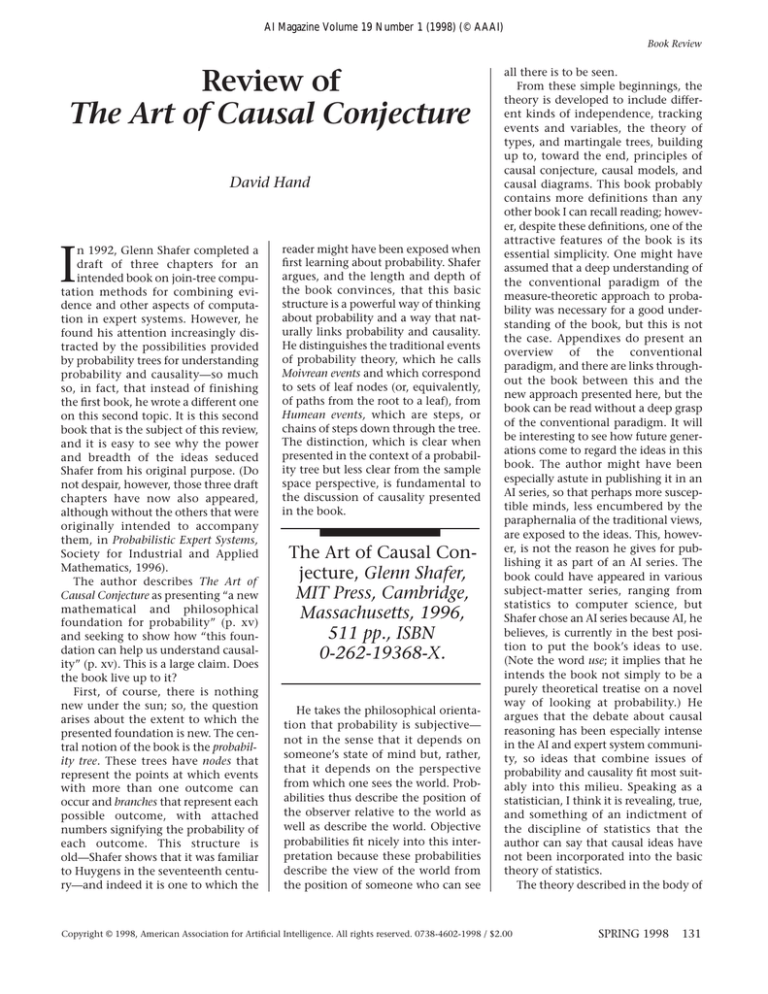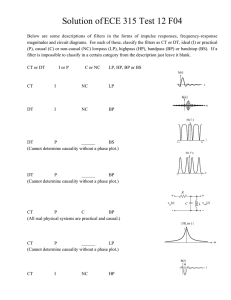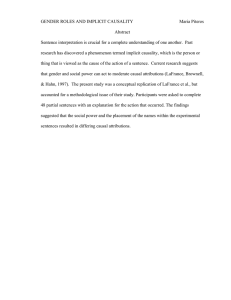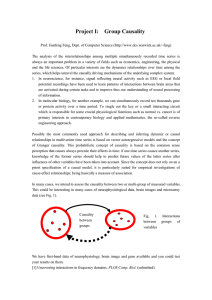
AI Magazine Volume 19 Number 1 (1998) (© AAAI)
Book Review
Review of
The Art of Causal Conjecture
David Hand
I
n 1992, Glenn Shafer completed a
draft of three chapters for an
intended book on join-tree computation methods for combining evidence and other aspects of computation in expert systems. However, he
found his attention increasingly distracted by the possibilities provided
by probability trees for understanding
probability and causality—so much
so, in fact, that instead of finishing
the first book, he wrote a different one
on this second topic. It is this second
book that is the subject of this review,
and it is easy to see why the power
and breadth of the ideas seduced
Shafer from his original purpose. (Do
not despair, however, those three draft
chapters have now also appeared,
although without the others that were
originally intended to accompany
them, in Probabilistic Expert Systems,
Society for Industrial and Applied
Mathematics, 1996).
The author describes The Art of
Causal Conjecture as presenting “a new
mathematical and philosophical
foundation for probability” (p. xv)
and seeking to show how “this foundation can help us understand causality” (p. xv). This is a large claim. Does
the book live up to it?
First, of course, there is nothing
new under the sun; so, the question
arises about the extent to which the
presented foundation is new. The central notion of the book is the probability tree. These trees have nodes that
represent the points at which events
with more than one outcome can
occur and branches that represent each
possible outcome, with attached
numbers signifying the probability of
each outcome. This structure is
old—Shafer shows that it was familiar
to Huygens in the seventeenth century—and indeed it is one to which the
reader might have been exposed when
first learning about probability. Shafer
argues, and the length and depth of
the book convinces, that this basic
structure is a powerful way of thinking
about probability and a way that naturally links probability and causality.
He distinguishes the traditional events
of probability theory, which he calls
Moivrean events and which correspond
to sets of leaf nodes (or, equivalently,
of paths from the root to a leaf), from
Humean events, which are steps, or
chains of steps down through the tree.
The distinction, which is clear when
presented in the context of a probability tree but less clear from the sample
space perspective, is fundamental to
the discussion of causality presented
in the book.
The Art of Causal Conjecture, Glenn Shafer,
MIT Press, Cambridge,
Massachusetts, 1996,
511 pp., ISBN
0-262-19368-X.
He takes the philosophical orientation that probability is subjective—
not in the sense that it depends on
someone’s state of mind but, rather,
that it depends on the perspective
from which one sees the world. Probabilities thus describe the position of
the observer relative to the world as
well as describe the world. Objective
probabilities fit nicely into this interpretation because these probabilities
describe the view of the world from
the position of someone who can see
all there is to be seen.
From these simple beginnings, the
theory is developed to include different kinds of independence, tracking
events and variables, the theory of
types, and martingale trees, building
up to, toward the end, principles of
causal conjecture, causal models, and
causal diagrams. This book probably
contains more definitions than any
other book I can recall reading; however, despite these definitions, one of the
attractive features of the book is its
essential simplicity. One might have
assumed that a deep understanding of
the conventional paradigm of the
measure-theoretic approach to probability was necessary for a good understanding of the book, but this is not
the case. Appendixes do present an
overview of the conventional
paradigm, and there are links throughout the book between this and the
new approach presented here, but the
book can be read without a deep grasp
of the conventional paradigm. It will
be interesting to see how future generations come to regard the ideas in this
book. The author might have been
especially astute in publishing it in an
AI series, so that perhaps more susceptible minds, less encumbered by the
paraphernalia of the traditional views,
are exposed to the ideas. This, however, is not the reason he gives for publishing it as part of an AI series. The
book could have appeared in various
subject-matter series, ranging from
statistics to computer science, but
Shafer chose an AI series because AI, he
believes, is currently in the best position to put the book’s ideas to use.
(Note the word use; it implies that he
intends the book not simply to be a
purely theoretical treatise on a novel
way of looking at probability.) He
argues that the debate about causal
reasoning has been especially intense
in the AI and expert system community, so ideas that combine issues of
probability and causality fit most suitably into this milieu. Speaking as a
statistician, I think it is revealing, true,
and something of an indictment of
the discipline of statistics that the
author can say that causal ideas have
not been incorporated into the basic
theory of statistics.
The theory described in the body of
Copyright © 1998, American Association for Artificial Intelligence. All rights reserved. 0738-4602-1998 / $2.00
SPRING 1998
131
Book Review
ADVANCES IN
KNOWLEDGE DISCOVERY
AND DATA MINING
Usama M. Fayyad, Gregory Piatetsky-Shapiro,
Padhraic Smyth, and Ramasamy Uthurusamy
editors
ISBN 0-262-56097-6
632 pp., index. $50.00 softcover
The AAAI Press • Distributed by The MIT Press
Massachusetts Institute of Technology, 5 Cambridge Center Cambridge,
Massachusetts 02142
To order, call toll free: (800) 356-0343 or (617) 625-8569.
MasterCard and VISA accepted.
132
AI MAGAZINE
the book (that is, distinct from the traditional material relegated to the
appendixes) has not been published
before. This approach might have the
advantage that it will gain more rapid
recognition for the achievement represented by the book because the accessible style means that the ideas can be
understood by even the relative inexpert; it is not necessary for the material to go through the standard stages of
being read by an expert, digested, and
translated into simpler terms for the
less knowledgeable. The author has
already taken these steps. That being
said, however, the simplicity of the
book, in the sense that it does not
depend on years of detailed mathematical study to read and understand,
should not detract from its depth. To
pick just one example, the notion of
weak independence in probability
trees leads to a nice way of making
Reichenbach’s notions of common
causes precise.
To me, this book also seems to provide a superb illustration of the merits
of going back and revisiting the writings of the greats of the past; for example, “the author first formulated the
probability-tree definition of independence and proved Proposition 5.1 in
the early 1980s, in the course of trying
to understand the seventh definition
in Bayes’s essay” (p. 133).
This book will amply repay careful
study. Given the easy style and attractive presentation, such study should
be a great pleasure as well as a thoroughly rewarding exercise.
David Hand is professor of statistics and
head of the Statistics Department at the
Open University, United Kingdom. He is
founding editor and editor in chief of
Statistics and Computing. He has published
over 150 papers and 15 books, including
Artificial Intelligence and Psychiatry, Discrimination and Classification, Artificial Intelligence Frontiers in Statistics, Construction and
Assessment of Classification Rules, and Statistics in Finance. His chief methodological
research interests are in the foundations of
statistics, multivariate statistics, and the
interface between computer science and
statistics. His main applications interests
are medicine, finance, and psychology. His
e-mail address is d.j.hand@open.ac.uk.








